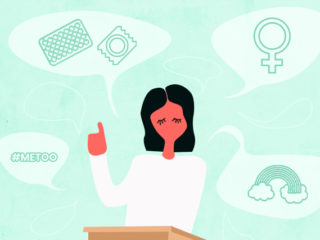
Happy labor day! While the holiday is a time to relax and get some much-needed time away from work, it’s also a day to reflect on the labor conditions we have right now. Today, we would especially like to highlight women in the workplace.
In honor of hardworking ladies out there, take a look at these facts you should know about.
Philippines is among the most gender equal countries in the world
Good news: According to a report by the World Economic Forum (WEF) released last December, the Philippines is one of the most gender equal countries worldwide with equal opportunities for men and women in terms of educational attainment, health and survival, political empowerment, and yes, economic participation and opportunity.
In the study, the Philippines ranked first in Asia and eighth in the world. Since the Geneva-based organization’s annual report was launched in 2006, the Philippines has consistently been in the top ten. In fact, we’re the only Asian country to achieve that.
According to ABS-CBN News, “The WEF also noted that the Philippines was near to closing 80 percent of its overall gender gap, the ;highest value’ for the country ever recorded by the index. The Philippines also recorded a closer gender gap in terms of economic participation and opportunity due to an increase in wage equality for similar work.”
Unfortunately, we can’t say the same for other countries. Worldwide, the report noted that the gender gap in the workplace meanwhile will take over two centuries more to close.
Women in power

The same study has noted that across the globe, political empowerment is sadly where the gender gap remains the widest among the four subindexes measured.
According to WEF, the global Political Empowerment gender gap “reflects low representation of women in all political roles and a particularly sporadic presence of women among heads of state.”
Globally, “only 19 percent of the gender gap in terms of head-of-state roles has been closed so far.” the report wrote. Adding, “Women are slightly better represented among ministers and congresswomen. Only 18 percent of ministers worldwide are women, and in six of the 149 countries studied, there are no women in ministerial positions at all. In addition, women elected in national parliaments represent just 24 percent of available seats across the globe.”
Moreover, similar to the previous year, only 23 percent of the political gap has been closed. While our country ranked 13th overall, WEF stressed that no country has yet fully closed political empowerment gaps. “Even the best performer in this subindex, Iceland, still exhibits a gap of 33 percent, and this gap has widened significantly over the past year.”
Meanwhile, while we are among the five countries where women and men “are already equally likely to attain managerial positions,” women across the globe still encounter significant obstacles in taking on managerial or senior official roles.
The report also wrote: “The presence of women in management roles is today one of the main barriers to overcome, both in the public and private sector.” Moreover, “income gaps across the world not only highlight persistent differences in pay, but also suggest that economic power is still typically in the hands of men.”
Most women get jobs with low salary and no security
Alternative news agency Bulatlat reports that a 2016 study showed, “women wage workers are mostly employed in industries with lower wages such as in wholesale and retail trade, manufacturing, agriculture and those who are employed in private households.”
The manufacturing industry reportedly has more than a million women wage workers. The study by the Center for Women’s Resources said they are mostly operating in special economic zones especially electronics and garments. “Because of regional wage rationalization, most women in manufacturing receive low wages, on the average, P337.”
Women in wholesale and retail trade or those working in malls and supermarkets reportedly receive about the same low wage per day, and at least 43 percent of them are non-regular workers.
The PSA on Labor and Employment 2016 data further noted a decline in the number of women employed in the agricultural sector. “One reason for the underperformance among women in agriculture is the trend to look for alternative sources of income outside agricultural production work due to the deteriorating condition of peasant families,” the study read.
“Other services activities” also have to be considered, especially since they comprise 1.8 million of women workers. “At least 89 percent of them are employed in private households. They also receive low wages, for as low as P2,500 a month, as mandated by the Kasambahay Law of 2012–much lower than the mandated minimum wage in the country,” Bulatlat notes.
In addition, WEF’s report stresses, “women tend to perform the majority of unpaid tasks (i.e. housework, household care, and other unpaid activities). In the 29 countries for which data are available, women spend, on average, twice as much time on these activities than men.”
Women in STEM

In their report, WEF also noted that women are significantly under-represented in growing areas of employment that require science, technology, engineering and mathematics skills.
It particularly highlighted the low participation of women within the artificial intelligence field, where they make up just 22 percent of the workforce. “This gap is three times larger than in other industry talent pools,” WEF statement pointed out, while stressing the “clear need for proactive measures to prevent a deepening of the gender gap in other industries where AI skills are in increasing demand.”
Also, while we remain fortunate in that there is more or less an equal amount of female to male researchers in the Philippines, data from the UNESCO Institute for Statistics (UIS) states that women account for less than 30 percent of the world’s science researchers. Moreover, “numerous studies have found that women in STEM fields publish less, are paid less for their research and do not progress as far as men in their careers.”
READ MORE: Women in STEM deserve the rockstar treatment too
Sexual harassment cases in the workplace
Sexual harassment remains one of the biggest problems in our country and the world. A survey by the Social Weather Stations (SWS) and UN Women reveals three in five women have experienced being sexually harassed, 50 percent of them did nothing after they were harassed, mostly because of fear, and that perpetrators commit sexual harassment regardless of their educational background and employment status. HR Nation notes, “In other countries, 38 percent of reported sexual harassment cases happens at work.”
While we have concrete numbers on these, data on sexual harassment in the Philippines is hard to find. Sadly, most of them go unreported. Despite the existing Anti-Sexual Harassment Act of 1995 which prohibits sexual harassment in the workplace, it remains prevalent.
According to the study by CWR, women in wholesale and retail trade, in agricultural sector, or those employed in private households are more likely to be “subjected to verbal, physical, and sexual abuse due to the private nature of their work.”
Additionally, UN Women reports that “Every year, about 172,000 Filipino women leave the country as migrant workers.” Adding, “Research has shown that women migrant workers are more likely than men to send money home to families, possibly as an extension of women’s traditional caregiving role in the household.” Sadly, many of those women continue to risk physical and sexual abuse. A Philippine women’s rights lawyer told DW.com that “despite a law to protect the nearly two million domestic workers in the Philippines, sexual abuse appears to be widespread, with the victims often choosing to remain silent.”
***
While we are seeing some progress in our country in terms of workplace conditions for women, we remain vigilant. As long as gender gap exists anywhere in the world, we won’t be satisfied.
Art by Tricia Guevara
For the latest in culture, fashion, beauty, and celebrities, subscribe to our weekly newsletter here
Follow Preen on Facebook, Instagram, Twitter, YouTube, and Viber
Related stories:
Unpacking stereotypes against women in the workplace
Purl is the adorable cartoon about gender discrimination in the workplace
5 warning signs of sexual harassment in the workplace
Working moms’ maternity leaves are now finally extended to 105 days


